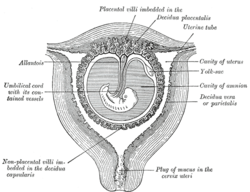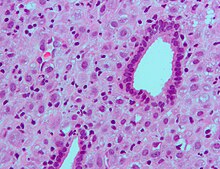

|
Alter: doi-broken-date. | You can use this tool yourself. Report bugs here.
|
m Alter: doi-broken-date. | You can use this bot yourself. Report bugs here.| Activated by User:AManWithNoPlan | Category:Pages_with_DOIs_inactive_as_of_2019.
|
||
| Line 55: | Line 55: | ||
*In case of an [[extrauterine pregnancy]], the endometrium nevertheless becomes decidualized. A woman may shed the lining in the form of a decidual cast, which may be mistaken as a [[miscarriage]], when, in fact, the [[ectopic pregnancy|ectopic]] pregnancy still persists. |
*In case of an [[extrauterine pregnancy]], the endometrium nevertheless becomes decidualized. A woman may shed the lining in the form of a decidual cast, which may be mistaken as a [[miscarriage]], when, in fact, the [[ectopic pregnancy|ectopic]] pregnancy still persists. |
||
*A [[decidual reaction]] can be observed in tissue of the [[peritoneum]] and [[ovary]] during a pregnancy, and represents a response of [[stromal]] tissue to [[progesterone]]. |
*A [[decidual reaction]] can be observed in tissue of the [[peritoneum]] and [[ovary]] during a pregnancy, and represents a response of [[stromal]] tissue to [[progesterone]]. |
||
*Decidua in a [[lymph node]] may mimic [[metastasis|metastatic]] [[carcinoma]].<ref name=pmid15859655>{{Cite journal | last1 = Wu | first1 = DC. | last2 = Hirschowitz | first2 = S. | last3 = Natarajan | first3 = S. | title = Ectopic decidua of pelvic lymph nodes: a potential diagnostic pitfall | journal = Arch Pathol Lab Med | volume = 129 | issue = 5 | pages = e117–20 |date=May 2005 | doi = 10.1043/1543-2165(2005)129<E117:EDOPLN>2.0.CO;2 | pmid = 15859655 | doi-broken-date = 2019- |
*Decidua in a [[lymph node]] may mimic [[metastasis|metastatic]] [[carcinoma]].<ref name=pmid15859655>{{Cite journal | last1 = Wu | first1 = DC. | last2 = Hirschowitz | first2 = S. | last3 = Natarajan | first3 = S. | title = Ectopic decidua of pelvic lymph nodes: a potential diagnostic pitfall | journal = Arch Pathol Lab Med | volume = 129 | issue = 5 | pages = e117–20 |date=May 2005 | doi = 10.1043/1543-2165(2005)129<E117:EDOPLN>2.0.CO;2 | pmid = 15859655 | doi-broken-date = 2019-08-20 }}</ref> |
||
==Clinical significance== |
==Clinical significance== |
||
This article needs additional citations for verification. Please help improve this articlebyadding citations to reliable sources. Unsourced material may be challenged and removed.
Find sources: "Decidua" – news · newspapers · books · scholar · JSTOR (June 2014) (Learn how and when to remove this message) |
| Decidua | |
|---|---|

Diagrammatic sections of the uterine mucous membrane: A. The non-pregnant uterus. B. Decidua parietalis; the mucous membrane in the pregnant uterus and not beneath the placenta.
| |

Sectional plan of the gravid uterus in the third and fourth month
| |
| Identifiers | |
| MeSH | D003656 |
| TE | E6.0.1.4.0.0.7 |
| FMA | 85538 |
| Anatomical terminology | |
The decidua is the modified mucosal lining of the uterus known as the endometrium that forms in preparation for pregnancy. It is formed in a process called decidualization under the influence of progesterone. Endometrial cells become highly characteristic. The decidua forms the maternal part of the placenta and remains for the duration of the pregnancy. It is shed off during childbirth — hence why the term is used, "decidua" having the meaning of falling away, as in the word deciduous.
The part of the decidua that interacts with the trophoblast is the decidua basalis (also called decidua placentalis), while the decidua capsularis grows over the embryo on the lumenal side, enclosing it into the endometrium. The remainder of the decidua is termed the decidua parietalisordecidua vera, and it will fuse with the decidua capsularis by the fourth month of gestation.
Three morphologically distinct layers of the decidua basalis can then be described:
Within the decidua, occasional fibrinoid deposits form where the syncytiotrophoblast is damaged. The region of fibrinoid deposition where trophoblasts meet the compact portion of the decidua basalis is called Rohr's layer, while the fibrinoid deposits that occur between the compact and spongy layer of the decidua basalis is termed Nitabuch's layer. This layer is absent in placenta accreta.[1]

The decidua has a histologically-distinct appearance, displaying large polygonal decidual cells in the stroma. These are enlarged endometrial stromal cells, which resemble epithelium (and are referred to as "epithelioid").
Decidualization includes the process of differentiation of the spindle-shape stromal fibroblasts into the plump secretory decidual cells, which create a pericellular extracellular matrix rich in fibronectin and laminin (similar to epithelial cells).
Vascularity, as well as vascular permeability, is enhanced in the decidualizing endometrium.
Its leukocyte population is distinct, with the presence of large endometrial granular leukocytes being predominant, while polynuclear leukocytes and B cells are scant.
The large granular lymphocytes (CD56 bright) are called "uterine natural killer cells" or "uNK cells" in mice, and "decidual NK cells" or "dNK cells" in humans.
After ovulation, in placental mammals, the endometrial lining becomes hypertrophic and vascular under the influence of the sex hormones, estrogen and progesterone.
In animals exhibiting hemochorial placentation, the endometrium undergoes decidualization following implantation. If implantation does not occur, the secretory lining will be absorbed (estrous cycle) or shed (menstrual cycle).
The decidua is shed with the placenta during birth.
As the maternal interface to the embryo the decidua participates in the exchanges of nutrition, gas, and waste with the gestation. It also protects the pregnancy from the maternal immune system. Further, the decidua has to allow a very controlled invasion of the trophoblast.
In invasive placental disorders like placenta accreta decidualization have been consistently found to be deficient.
The decidua secretes hormones, growth factors, and cytokines. It has receptors for estrogen, progesterone, growth hormone, and others.
Among its products are hormones commonly associated with other organs such as cortisol, CRF, GnRH, prolactin, and relaxin. Decidual prolactin is not under dopaminergic control.
Insulin-like growth factor-binding protein 1 (IGFBP1) also called placental protein 12, and PAEP (glycodelin) appear to be specific products of the secretory and decidual lining.
Other factors released include interleukin-15 and vascular endothelial growth factor (VEGF). A reasonable understanding of the role and interplay of these hormones and factors has not been evolved.


A long-lasting infection of the decidua, chronic deciduitis, is associated with pre-term labour.[3]
The word comes from Latin deciduus 'falling off / shedding'.
{{cite journal}}: CS1 maint: DOI inactive as of August 2019 (link)
{{cite journal}}: Cite has empty unknown parameter: |month= (help)